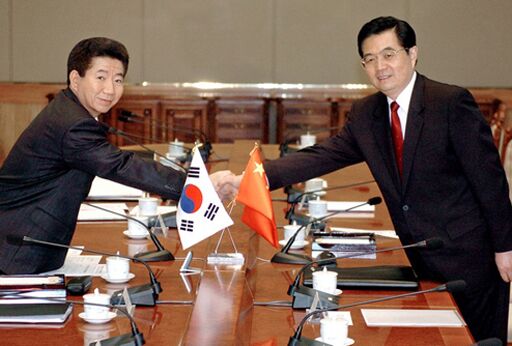
America’s Influence in Asia Declines
America has traditionally enjoyed close relations with a number of Asian states, particulary Japan, South Korea and the Philippines. Even today, many Asian nations, including Thailand, are working closely with America—especially in the war against terrorism.
But this is changing.
Consider America’s relationship with South Korea. Once close allies, Seoul and Washington have now drifted so far apart that, according to the Asia Times, “there is now speculation the longtime partners are getting close to divorce” (March 7). Once a stalwart ally of America in its quest to disarm North Korea, it now looks like South Korea wants to reduce its support of American efforts.
Speculation of a divergence between Seoul and Washington’s interests intensified recently when it was alleged that North Korea was counterfeiting U.S. dollars, and that South Korea was reluctant to help America deal with the situation. Relations between the nations have deteriorated so badly, that “[i]t is believed U.S. officials no longer trust in their South Korean counterparts on North Korea policy” (ibid.).
With America enmeshed in a convoluted and dirty battle with Iran over its nuclear program, Washington relies heavily on support from Asian nations to maintain pressure on North Korea over its nuclear program. By declining to throw it’s weight behind many of America’s efforts, the South Korean government is sending a message to Pyongyang that the United States and its allies aren’t totally united in their dedication to disarming North Korea. The division between America and South Korea on this issue conveys a weakness of position and a lack of solidarity in purpose. Should the crisis overflow to impact Washington’s relations with Japan, America’s chances of ever shutting down North Korea’s nuclear program are virtually nil.
Another sign of South Korea’s reluctance to assist the U.S. is President Roh Moo Hyun’s refusal to grant permission to the U.S. Defense Department to dispatch U.S. forces into regions near and along the Korean Peninsula, such as the Taiwan Strait, “whenever there is a security crisis in the region” (ibid.). In spite of the fact that it has been one of Seoul’s staunchest allies, America still can’t count on a reciprocating level of support from South Korea.
There are a number of reasons why America’s relations with Asian nations are deteriorating. Perhaps the most notable is that it has not been giving Asia the attention that it warrants. With its military and its politicians trying to shore up relations and put out fires in Latin America, Europe and the Middle East, America has been distracted from devoting enough attention to Asia. Concurrently, China has been doing just the opposite.
China is willingly filling the void being left by the U.S. As far back as 2003, the Far Eastern Economic Review presented the likely outcome of this Sino-American mêlée: “China’s feverish economic diplomacy has forged closer ties with the Association of Southeast Asian Nations [incorporating 10 Asian nations], Japan and South Korea, stimulating trade and investment that the United States warmly welcomes. But behind Beijing’s ‘win win’ rhetoric of gains for everyone lies another agenda that Washington may find less palatable in the long run. In a little-noticed ‘Strategic Partnership’ agreement, which China and asean quietly signed in Bali in early October, are buried the seeds of closer security cooperation that analysts and officials say China aims to use to dilute American influence in the region” (Nov. 20, 2003; emphasis ours throughout). With Beijing’s power and prestige increasing from year to year, the nation is steadily replacing America as the nucleus around which Asian nations revolve.
The article quoted a senior asean official: “They want a situation in Southeast Asia that automatically takes into account China’s interests. The whole objective of the policy is to avoid strategic encirclement by the U.S.” (ibid.). China is finally acting on its long-held ambitions to unite East Asia and is squeezing out U.S. interests there.
Beijing’s plans for its Asian brothers extend beyond the south and east. “China’s ambitions stretch farther than asean. … China has a road map that envisages a Northeast Asia Free-Trade Agreement encompassing Japan and Korea, and a pan-regional East Asian fta. Chinese commentators, reflecting official thinking, envisage an East Asian economic and security community with institutions like an Asian Monetary Fund and an Organization of East Asian Cooperation … within five years” (ibid.).
In its November/December 2003 issue, Foreign Affairs wrote, “China is rapidly emerging as the engine of growth in Asia, which affords it increasing influence and leverage. Although the United States remains the strategic incumbent there, Washington needs to pay consistent attention to managing relations with regional friends and allies if it hopes to maintain its pull.”
Make no mistake: China is quickly becoming the nucleus of Asia, and an attractive alternative to America as an ally. From Kazakhstan to the Philippines, Japan to Thailand, and every nation in between, Beijing is forging a foreign policy aimed to passively increase its influence in the region. On its western borders, China has made such uncharacteristic gestures as conceding long-disputed tracts of land to historic rival India and other central Asian nations. Through warm gestures such as gigantic trade and commerce deals, Beijing is causing Eastern nations to grow more reliant on China.
Beijing’s ascent as Asia’s new powerhouse could not have been timed more perfectly for Asia. With America distracted away from its traditional responsibilities toward many Eastern countries, many Asian nations are warming up to the idea of reorienting their policies around China, rather than America. Comforted by China’s growing military, booming economy, and newfound geopolitical might, watch for Asian nations to grow more willing to slip out from under the red-white-and-blue umbrella and seek shelter under the straight red umbrella of communist China.
